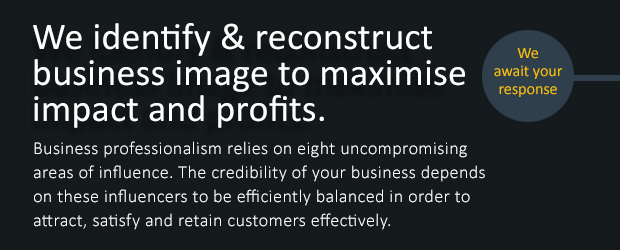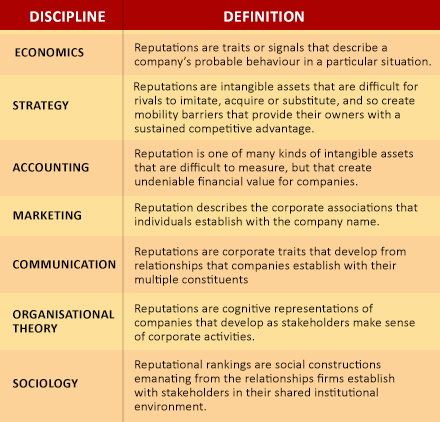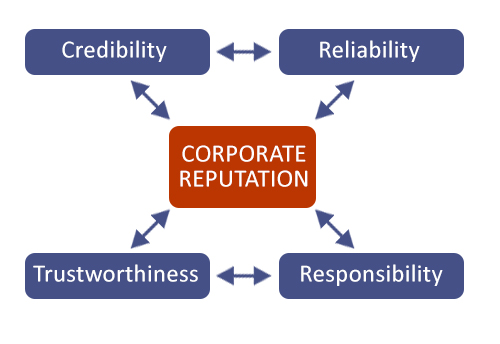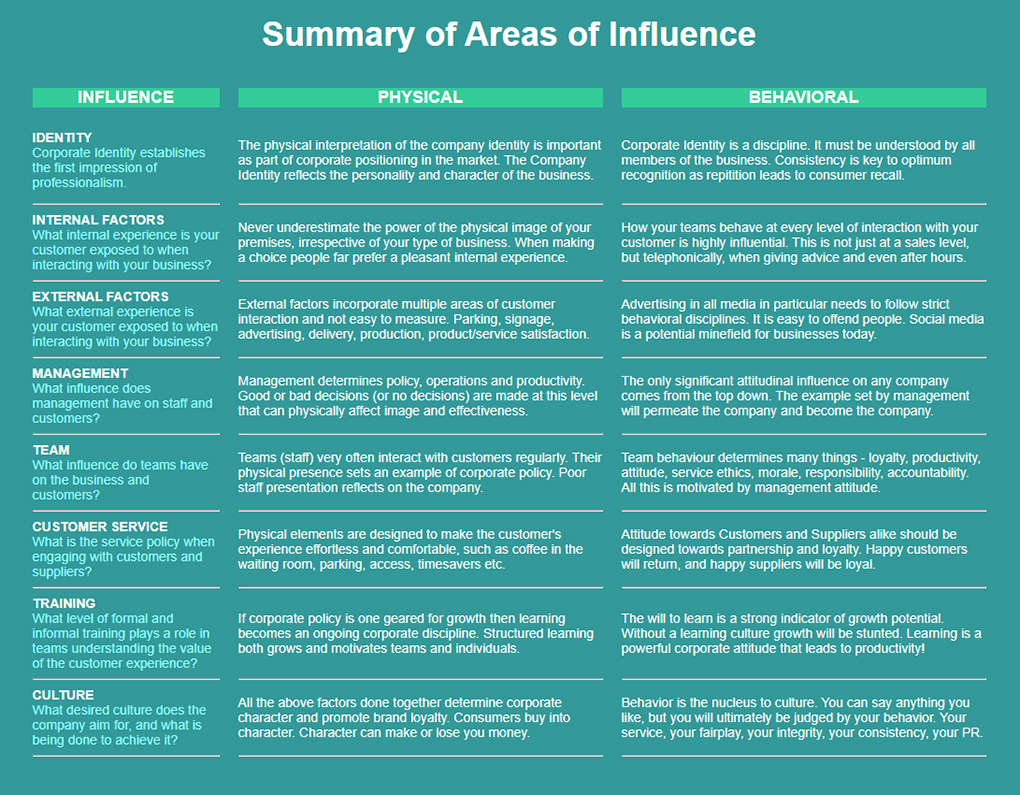| |
|
|
 |
Discover what we
can do for your
company right now

|
|
 |
| |
|
| |
| |
“Every company, big or small, creates an impression.
Is your company creating a lasting impression?" |
| |
|
|
It is a common misperception that Corporate Identity is represented by a logo, business card, letterhead and some colour disciplines. This naive concept that has become the standard for our understanding of what corporate identity is, has not done any favours for many businesses that fall short of the corporate discipline. It does not help to have a great logo but your reception looks like a dog's breakfast, or to have beautifully designed business cards but your delivery van is a rust-bucket, or to make pretty promises but your staff are incompetent and service is poor.
Essentially there are eight areas of influence that any business, large or small, needs to take into account when setting out to be taken seriously by their customers, suppliers and competitiors. Only one of the eight incorporates the logo and corporate colour schemes etc. The other seven areas are, to a lesser and greater degree responsible for the overall 'experience' that a customer has when engaging with a business, irresepective of the size of the business or the industry that they trade in. This set of disciplines therefore applies to startup business as much as large companies, panel beating shops as much as cosmetic stores, NGO's as well as Propriety business, online business as much as retail.
It is a fact that corporate image and behavior play a significant role in the financial success of a business. If it didn't, big business wouldn't take it so seriously. It is important to note that a successful business did not first become successful and then improve their corporate image, they became successful because they took their corporate image seriously right from the start.
Every customer responds directly to the 'experience' they have with any business. If the experience is bad they do not return. If the experience is good they may come back. If the experience is exceptional they will keep returning and they will tell everyone about it. If this is true, which it is, then we can confidently assume that the more often a customer returns, and the more often they refer your business to others, the more money you will make. Therefore, image equates directly to turnover which translates to profits. Image sells, and anyone who ignores this will compromise their success significantly.
The image you portray as an individual is just as important and influential to a customer as the image your physical business projects. As a customer you enjoy walking into a well managed and attractive store or business. So why should that be different in your business? Customer service is a critical part of the image you project. An image is what your prospect remembers you by. It may be your advertising image, your service image, your delivery image, your staff image, your store image. Your customer's positive (or negative) experience is projected as much by you and your staff as by any other means.
People do not remember what you did for them as much as they remember how you made them feel.
Think of yourself, and your own personal image. The way people experience you is not determined by looks alone, but by the way you behave as well. In fact, your behaviour is vastly more important in the long term than your looks. |
|

It is no different with your business. Looking good creates the first impression, but exceptional behavior is what creates the lasting impression.
Most businesses change over time more by accident than by design. Strategically planned image generation is a vital part of maintaining consistency in the process of developing a brand persona. Imagine McDonald's, or Mercedes, or Apple projecting a confusing brand image. they would never be where they are now. Their image is carefully designed right down to what the lady at the till ays when upselling, or the overall that the cleaner wears, or the serviettes, or the way the meal is positioned on the plate. If you do not strategically deliberate the image you wish your company to project, and install disciplines and guidelines to ensure its consistency then you will end up with a poor image at best, and pitiful few customers at worst.
Image projection is in the detail. If your delivery guy turns up at your customer's doorstep and his motorbike is spewing smoke and the delivery box on the back is barely held on by a loose bolt then this will create an impression...and not a good one. No one then remembers the delivery guy as much as they remember the 'experience' they had with your business. If they have more similar experiences with your receptionist, mechanic, salesperson etc. then the perception of your business professionalism will decline significantly.

|
| |
|
|
| |
|
|
| The Perceptione Image Architecture |
| |
|
|
| At Perceptione we have researched and analysed the common critical factors that significantly influence positive customer engagement with a business, product, service or brand. These factors do not |
|
depend on type of industry or type of business, but are common influencers in every business from local plumbing to international telecoms. Creating a balance within these disciplines is the objectve. |

|
|
The Perceptione Image Architecture diagram opposite indicates the eight factors that influence a business' image and personality. These eight become the disciplines by which a business can measure its level of professionalism regarding customer engagement.
These factors range from visual identity, to internal and external influences, staff and management behaviors, service and competency levels and corporate community. Every one of these factors contributes to a favourable image, and each one involves both physical and behavioral influences.
Perceptione can identify in your business the potential for more meaningful customer engagement experiences by addressing some or all of the above influencing factors. It is not only a fancy business card that creates an impression, but also staff attitude, the reception experience, the internal decor, advertising (both traditional and digital), signage or parking availability, to mention only a few that impact on your prospect or existing customer. |
| |
|
 |
|
| |
| |
These are all touch points i.e. where the customer experiences
your product or service both consciously
and/or subliminally.
All are very effective in creating a positive relationship.
All of these factors determine
whether your customer finds you,
engages with you and returns for more business.
Done well these factors
attract repeat transactions,
therefore they make
money thereby generating real profits. |
| |
| |
|
|
|
|
|
|
|
IDENTITY
Corporate Identity
establishes the first
impression of
professionalism |
|
INTERNAL FACTORS
What internal experience
is your customer exposed
to
when interacting with
your business? |
|
EXTERNAL FACTORS
What external experience
is your customer exposed
to
when interacting with
your business? |
|
MANAGEMENT
What influence does
management have on
staff and customers? |
 |
|
 |
|
 |
|
 |
TEAM
What influence do
teams have on the
business and customers? |
|
CUSTOMER SERVICE
What is the service policy
when
engaging with
customers and suppliers? |
|
TRAINING
What level of formal and
informal training plays a
role in teams understanding
the value of the experience? |
|
CULTURE
What desired culture
does the company aim for,
and what is being done
to achieve it? |
| |
|
|
|
|
|
|
|
| |
| |
|
|
For a professional consultation and preliminary image audit please complete the form opposite and we will
call to set up an appointment physically or on a digital platform. Our meeting with you, your brief and the preliminary audit will serve to determine costs which
will be estimated and approved before we go ahead
with any work. We look forward to dealing with you. |
Discover what we
can do for your
company right now

|
|
| |
|
|
|
 |
| |
 |
| |
| The Case for Corporate Reputation |
| |
Below are recent editorials from reputable sources on the value of the Corporate Image,
also referred
to as
Corporate Reputation. The case is undeniably very strong, and in
some
instances
reflect that as much as 70% of a company's success can be directly
attributed to its
reputation. It is important to note that the success or failure of
a
business
reputation is
determined by the customer's response to the efforts
of
that business to satisfy
and exceed the expectations of the customer. |
 |
| |
 |
 |
|
The following is an article written by Harsh Pamnani for Business World in May 2020
on the importance of Corporate Image. |
 |

Corporate image is one of the most important assets of an organisation. It acts as a comfort factor for customers and assures them that they are buying from the best.
A lot of startup enthusiasts think and talk about starting businesses, building products, acquiring customers and beating competition. It is very important to get inspired and learn on how to start and scale businesses, but at the same time, it is equally important to understand the importance of corporate image.
Corporate image is one of the most important assets of an organisation. It acts as a comfort factor for customers and assures them that they are buying from the best. Moreover, it influences attitudes of not only customers but also employees, media, analysts, influencers etc. towards an organization. It is difficult to build a strong corporate image in a highly crowded and competitive environment, and it is much more difficult to regain it if image has got tarnished due to certain reasons.
Actions of leaders and employees, performance of products and financial success of organizations make a huge impact on the image of organizations, and create market perceptions & sentiments - what people think and feel about them.
Let's have a look at a few examples where corporate image of highly recognized businesses got negatively impacted due to various reasons:
Impact of leadership actions: The recent removal of Cyrus Mistry from the post of Chairman of Tata group has negatively impacted the image of one of India's most respected and largest conglomerate Tata group. Tata group companies lost a huge market value after the ousting of Cyrus Mistry. Media coverage on Cyrus Mistry vs Ratan Tata has created invisible and long term damage to the organization, such as the negative impact on brand trust and reputation, customer sentiments, employee morale and so on.
Impact of product performance: When Samsung Galaxy Note 7 was released, it received overwhelming praise for its design and features. It was in high demand at the time of its launch and broke pre-order records in South Korea and faced delays in international releases due to supply shortages. However, in September 2016, Samsung suspended sales of the Galaxy Note 7 and announced a voluntary recall after it was found that a manufacturing defect in the phones' batteries had caused some of them to generate excessive heat, resulting in fires and explosions. The defect in this product led to negative media coverage, a costly product recall, and pressure on revenues and profits.
Impact of business performance: Flipkart had been a darling of investors and used to be recognized as one of the most valuable startups in India, in fact the poster boy of Indian startup ecosystem. But then investors began to wonder about its valuations. Analysts and influencers questioned its business model, a few key leaders left the organization and the company couldn't give on time joining to new hires from the top institutes. Additionally, unhappy customers from 2014 Big Billion Day sale and tough competition from Amazon and Paytm added to pressure on business performance. |
|
Impact of employee actions: Though different discussions have been happening around whether Uber drivers are self-employed contractors or Uber employees, for customers these drivers are like employees as they represent Uber and customers travel with them due to trust on Uber. In Dec 2014, one of the Uber's driver Shiv Kumar Yadav accused of raping a woman in his taxi in Delhi. This incidence caused a lot of damage to brand image of Uber in India.
The above examples show that organizations have to be paranoid as a few incidences could damage their hard earned corporate image.
As we have looked at the importance of corporate image and a few examples of how it could get impacted, let's have a look at a few of the factors that help in building the corporate image:
1. Management team: If an organization has well known and respected leaders in its board and executive team then they add on to its image. Additionally, if a company is funded by well-known investors, then also people consider it as one of the upcoming leaders. But, just by having big names in management would not help, proper collaboration and mutual respect among them is very much necessary.
2. History: Previous performance of the company in terms of factors such as rising market share, rising profits, rising alliances, rising distributors, rising vendors, rising customers, successful products, customer testimonials etc. adds on to the image of organization.
3. Products market recognition: Previous successful products add on to the positive image of an organization and create positive customer perceptions about the abilities of a company.
4. Financial Success: Financial results play a very important role in building corporate image. Everybody wants to know and write about success story of profitable companies, financial analysts recommend them to investors and customers feel secure about buying from a company with substantial financial base.
5. Top notch customers: Quality of customers is more important than quantity of customers. An impressive customer list can enhance image of a company as an innovator and leader in its industry. Moreover, word of mouth from top notch customers creates pull for many other customers.
6. Employee loyalty: Employees' alignment with the purpose of company and loyalty towards its customers and management adds a lot of value in terms of corporate image.
Corporate Image is fragile and every action by organization, its leaders and employees matters in terms of creating people's sentiments. If sentiments are positive, people do positive word of mouth about the company that helps in lower customer acquisition and retention cost, better margins, employee loyalty, shareholder value and positive media attention. But if sentiments are negative, organizations could get into negative performance spirals.
Disclaimer: The views expressed in the article above are those of the authors' and do not necessarily represent or reflect the views of this publishing house. Unless otherwise noted, the author is writing in his/her personal capacity. They are not intended and should not be thought to represent official ideas, attitudes, or policies of any agency or institution.
|
|
| |
| |
It takes more than just the visual media to be the vehicle that transports the
corporate message, position, culture and policy to the market. Done well there
are a host of elements that influence a
meaningful and memorable impression
on your existing and prospective consumers. |
| |
| |
 |
| |
 |
 |
 |
|
The following is a summary of an article on
Nike presented by Coventry University on
‘The importance of Corporate Reputation above products and services’.The full article can be read here. |
 |
Nike Corporate Reputation Report
As Presented by Coventry University
March 2015
What is Corporate Reputation?
Cambridge University describes reputation as being the opinion that people in general have about someone or something, or how much respect or admiration someone or something receives, based on past behaviour or character. (Dictionary.cambridge.org; 2015).
According to Ernst and Young, 30% to 50% of a company’s value is intangible as it is based solely on corporate reputation. However, other investment companies believe that up to 70% of a company’s value may be intangible (Burke; Martin and Cooper; 2011).
Reputation refers to different aspects of a company such as leadership, management, quality of products and services and above all relationships with different stakeholders (Argenti and Druckenmiller; 2004).
So important is the corporate reputation, that there are different definitions of corporate reputation varying from discipline to discipline (Fombrun;2000).

The 4 Elements of Corporate Reputation:
Fombrun (1996) defines reputation as being “the net perception of a company’s ability to meet and exceed the expectations of all its stakeholders.” (Roper and Roper; 2012 p. 5). According to Fombrun, corporate reputation mainly consists of four elements which are: Credibility, Reliability, Trustworthiness and Responsibility (Fombrun; 1996).

Illustrates the interrelatedness between these 4 elements.
This report shows how Nike is a strong company that works very hard on its reputation as it has identified that reputation is key for success. It has always been considered as a leader in footwear and sports apparel. The sweatshop scandal in India during the ‘90s hit the company and their reputation hard.
However, such setbacks did not hold the company back. Faced with a situation without precedent Nike decided to take responsibility and work hard in trying to regain the consumers’ trust. By doing this, not only did Nike move beyond the issue, but they became global role models.
. |
|
If Nike can “Just Do It”, so can others. (Herinst.com; 2015). By producing and making their “Sustainable Business Performance Summary” report available to all, Nike have opened a preferential channel with their customers. This channel provides transparency between the company and its stakeholders, thus improving their reputation. In fact, “working conditions in Asian factories had improved drastically since Nike began business 25 years before, and that workers in shoe factories just ten years before who had gone to sleep and woken up today would think they had died and gone to heaven.” (Herinst.com; 2015)
What is a Brand?
According to the American Marketing Association a brand is the “name, term, design, symbol, or any other feature that identifies one seller’s product as distinctive from those of other sellers” (Ama.org; 2015). Therefore a brand is a product, service, or concept that is publicly distinguished from other products, services or concepts so that it can be easily communicated and effectively marketed.
Brand Equity?
In order for a brand to be successful it sets out to achieve brand equity. Referring back to the American Marketing Association, brand equity is, from a consumer perspective, “the value of a brand based on consumer attitudes about positive brand attributes and favourable consequences of brand use.” (Ama.org; 2015).
In customer’s minds, the brand must resonate in the way the brand wants to portray itself, therefore the customer’s thought and feeling of a brand should be that portrayed by the brand itself, thus building a loyalty towards the brand. By appealing both to the rational and emotional elements of humans, a strong brand provides consumers with multiple access points to the brand while reducing all competitive vulnerability (Keller; 2001). Nike’s brand is nowadays known worldwide. The ‘swoosh’ is one of the most iconic logos that is linked to a particular brand and the ‘Just Do It’ slogan is synonymous with Nike.
Corporate Branding is when a corporation decides to promote the reputable name of the corporation itself rather than specifically the product or service. Bigger credibility is at stake here, and a specific product/service can benefit from the reputation that is garnered by the corporation.
Why is it important to manage Corporate Reputation?
As seen all throughout the report, it is of vital importance that a company or a brand deals directly with its corporate reputation. Corporate reputation is the responsibility of everyone in a company. That is why this report analyses how important different stakeholders are, whether they are external such as the customers, or internal such as the employees of a particular firm. Corporate Reputation is the most important tool in any company’s toolbox, as was witnessed in the ‘sweatshop scandal’ of the ‘90s. Nowadays Nike is a flourishing company with a very strong brand equity and an equally strong corporate reputation. Nike is now one of the leaders in global brand reputation that makes billions of dollars. It is safe to say that Nike is successful. The ‘sweatshop scandal’ which started 24 years ago is the biggest reason as to why a company should manage its own corporate reputation effectively.
Conclusion:
This report suggests that in order to gain a good reputation Nike worked hard on its CRM (Customer Relationship Management). CRM, the ability to engage meaningfully with customers at all levels of business, allowed Nike to have better control on the proceedings of the company and was able to provide the different stakeholders with what they wanted i.e. sustainability and transparency. CRM allowed customers to forget Nike’s transgressions, and through brand equity Nike managed to draw out an emotional bond between the customers and the brand, so much so that they became advocates of the brand.
Disclaimer: The views expressed in the article above are those of the authors' and do not necessarily represent or reflect the views of this publishing house. Unless otherwise noted, the author is writing in his/her personal capacity. They are not intended and should not be thought to represent official ideas, attitudes, or policies of any agency or institution.
|
|
| |
 |
|
| |
|
|
For a professional consultation and preliminary image audit please complete the form opposite and we will
call to set up an appointment physically or on a digital platform. Our meeting with you, your brief and the preliminary audit will serve to determine costs which
will be estimated and approved before we go ahead
with any work. We look forward to dealing with you. |
Discover what we
can do for your
company right now

|
|
| |
|
|
|
| |
 |
| |
| |
 |
| |
| |
People buy from businesses that impress them,
therefore creating a good impression makes money. |
| |
|
